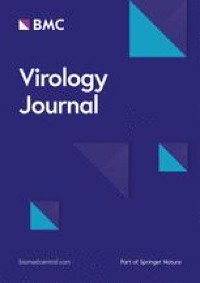Genetic variability in the E6 and E7 oncogenes of HPV52 and its prevalence in the Taizhou area, China - Virology Journal - Virology Journal

Persistent high-risk HPV infection has been identified as a major risk factor for cervical cancer. In China, the infection rates of high-risk HPV, such as HPV16, 18, 52, and 58, increase with the severity of cervical lesions [5, 7]. The overall HPV infection rate (21.3%) of this study was significantly different from that of Yangqu (8.9%), Xinjiang (14.0%), and Shandong (28.4%) but similar to that of other regions in Southeast China, such as Hangzhou (22.4%) and Jiangxi (22.5%) [15,16,17,18,19]. Many factors, including different economic conditions, cultural diversity, HPV vaccine awareness and lifestyles, might be the reasons for the differences in HPV infection rates in different geographical regions [7, 20, 21].
In this study, HPV52 was the most prevalent HPV type, followed by HPV58, 53, 16, 81, 39, 61, and 18. It is worth noting that the Gardasil 9-valent prophylactic vaccine approved for marketing in China in 2016 mainly targets HPV 6, 11, 16, 18, 31, 33, 45, 52, and 58. Therefore, the development of polygenic vaccines containing HPV53, 81, 39, and 61 would be more helpful for Chinese women to prevent HPV infection. Among all HPV types in China, the infection rate of HPV52 was relatively low in the late 1990s but has gradually increased since then [6, 7, 22]. Recently, HPV52 has become the most prevalent type among the Chinese population [6, 8, 9, 17,18,19, 30]. Furthermore, the oncogenicity of HPV is mainly attributable to the combined effects of the E6 and E7 oncoproteins. Accordingly, therapeutic vaccines against HPV E6 and/or E7 have been widely studied [23]. Based on our previous findings, genetic variation in the E6 and E7 genes was found to be highly associated with the risk of cervical cancer [24,25,26]. The genomic characterization of the HPV52 type has obvious epidemiological characteristics, which may be one of the factors that increase the risk of cervical cancer in Chinese women.
We obtained 325 complete sequences of the E6 and E7 genes from HPV52 in the Taizhou area. Most of the HPV52 (96.6%) variants belonged to lineage B, which was consistent with previous reports on HPV52 (sub)lineage distribution in East Asia [27,28,29,30]. It has been reported that lineage B predominated in Asia, while lineage A was the most common lineage in Africa, the Americas and Europe [27]. Given the dominance of HPV52 lineage B detected in our population, the results showed that for HPV52, any association between a specific (sub)lineage and a higher risk of CIN2 or worse lesions could not be well evaluated. Other (sub)lineages were not included in these analyses due to small numbers of samples. In addition to the HPV52 variants of the B lineage, the remaining 52CNTZ27 belongs to the A1 sublineage, and 52CNTZ25 and 52CNTZ26 belong to the C2 sublineage, accounting for 1.2% and 2.2%, respectively. A previous study showed that lineage B had a higher risk of cervical cancer than lineage A (OR: 5.46, 95% CI 2.28–13.07) [27]. Therefore, our results suggested that the reported high attribution of disease to HPV52 in the Taizhou area may be due to the high infection rate of lineage B in our population. However, our existing results could not be used to assess the association of the HPV52 (sub)lineage with the risk of cervical lesions because HPV52 variants were strongly biased towards lineage B. A study investigating the worldwide distribution of HPV52 variants suggested that all lineage B variants identified were sublineage B2, with 89.0% in Asia, 5.5% in Americas, 1.1% in Europe and zero in Afric [27]. Studies from Japan and Korea on HPV52 variants also suggested that all lineage B variants identified were sublineage B2 [29, 31]. During the long history of virus evolution, these HPV52 variants of lineage B may match the characteristics of the East Asia population through unknown viral adaptation mechanisms.
Compared with the HPV52 reference sequence (GenBank: HQ537732), the four most prevalent nucleotide substitutions were G350T (98.8%), A379G (K93R) (96.3%) in the E6 gene and C751T (96.6%), A801G (98.8%) in the E7 gene, which were specific to HPV52 lineage B. Of these, K93R was the only nonsynonymous substitution. Notably, in this study, there were three amino acid changes in the 93rd genetic code of the E6 oncoprotein, K93G, K93Q, and K93R, but no significant trends between the nucleotide substitutions of HPV52 variants and the risk for cervical carcinogenesis were observed. Previous studies have shown that K93R was associated with an increased cervical lesion risk in Korean women, but it has no correlation in Chinese women [31,32,33]. The sequence variants of amino acids may lead to different levels of pathogenicity due to geographical location or ethnic discrepancies. An in vitro study found that although K93R did not increase the immortalization ability of HPV52-positive cells, stronger colony formation and greater cell migration ability were observed when compared to its prototype and other variants [27]. In addition, the roles of synonymous substitutions G350T, C751T and A801G in lineage B on the risk of cervical cancer need to be further studied. Moreover, further functional studies should be conducted to understand the molecular mechanism of how these HPV52 variants of lineage B contribute to enhanced carcinogenicity, together with elucidation of the genetic background of Chinese people, including human leukocyte antigen polymorphisms.

Comments
Post a Comment